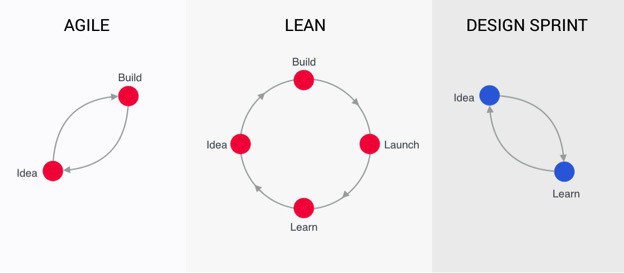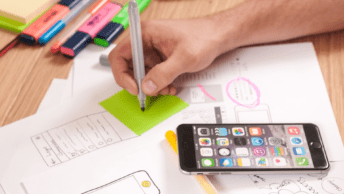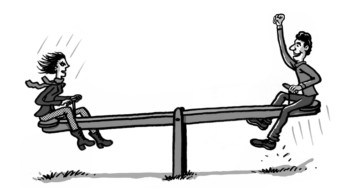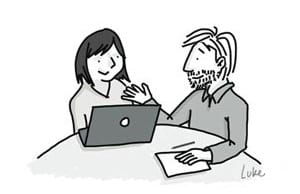By now, everyone in the technology industry has either heard of, or worked in agile sprints. But what about design sprints? Popularised by GV, Google’s venture capital arm, design sprints are an effective way to rapidly test and prototype ideas in the space of a week. In this article, I’ll look at how design sprints fit in with existing Agile and Lean methodologies, and how you can decide if a design sprint is the best approach for your latest project.
Traditional, Agile and Lean processes
Processes and methodologies provide a framework teams with diverse skills to work together effectively. Modern tech teams are highly sophisticated and made up of people with a diverse range of skills – product managers, visual designers, developers, and user experience designers, who all bring their individual perspectives to a team.
UX has traditionally followed a waterfall-like process where research is strictly followed by design, which is then followed by testing. Each stage is finished before another starts, and there are no strict guidelines as to how long each stage should take.
Agile UX exploded in popularity as UX designers desperately tried to fit into a methodology optimised for developers. Agile has led to quicker development times because it provides developers with a clear framework for managing work. However, when UX designers try to fit into a developer’s methodology, the best UX ideas don’t always get built, tested and validated.
Next came Lean methodology, and the concept of the minimum viable product, made famous by Eric Ries. The accepted wisdom was to launch as quickly as possible, with a heavy emphasis on building quickly, launching quickly and then iterating. Each cycle is made as short as possible, which means that testing the idea or the user experience only happens after the product is built and launched.
What is a design sprint?
While these methodologies all have speed in common, design sprints work a little differently. Before we dig deeper, here is Google’s definition of a design sprint from their GV arm:
The sprint is a five-day process for answering critical business questions through design, prototyping, and testing ideas with customers.
There are many more explanations and guides on design sprints so I won’t go into too much detail. If you want to know more, I highly recommend Google’s free 46-page guide.
How are design sprints different?

From this diagram, you can see the key difference in methodologies in the focus, resources and speed of each approach:
- Focus: Agile on build; Lean on launch; design sprint on idea(s).
- Resources: Agile requires heavy development resources; Lean requires resources from the whole company; design sprint requires only a design team.
- Speed: Agile has short cycles – two weeks; Lean has longer (undefined) cycles depending on the company; design sprint has the shortest cycles – 5 days.
When should you use design sprints in your company?
| Process | The UX designer’s point of view |
| Agile sprints | UX designers try to fit into a development process. The process is optimised for quick build times. Developers learn from testing the code. Designers learn when several sprints have passed and a new release is launched. |
| Lean methodology | UX designers try to fit into a business product development process. The process is optimised for quick launch times. Product and business teams learn from market interactions e.g. number of sign ups, traffic, revenue. Designers learn from analytics and post launch testing. |
| Design sprints | The design team prototypes, tests and validates ideas before they are built or launched. The team learns from user testing feedback and then iterate in a weeks time. |
Design sprints are effective when you want innovation: when you’re solving NEW and BIG problems. It doesn’t have to be for a completely new product, it could be for a new feature you want to explore.
When you want to find innovative solutions to unique problems, both Agile and Lean methods have the potential to lead to wasted development time and resources.
In order to innovate, UX and design teams need to be given the time, resources and framework to rapidly test ideas, which is why I believe design sprints are so useful for innovation. Design sprints allow teams to iterate quickly, and help organisations decide whether to invest in a new idea.
In summary
Design sprints are the quickest way to validate ideas, because all the other distractions are eliminated. The Lean process validates many more aspects of a product, including product/market fit, market factors and of course aspects related to the build. Agile focuses on quickly building a product and iterating from there. Next time you’re looking to innovate a product or feature, see if a design sprint can help you launch a more effective product faster.
Useful and relevant reads on integrating UX into Lean & Agile processes
- Lean UX: Getting Out Of The Deliverables Business by Jeff Gothelf
- The UX Professionals’ Guide to Working with Agile and Scrum Teams by Aviva Rosenstein
Have you used design sprints? Did they work for the design challenge you were facing? Chat to us in the UX Mastery forums





